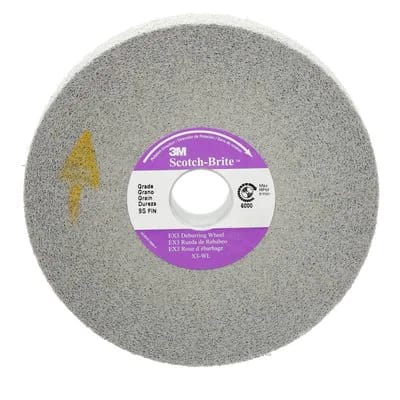SEE ALL CATEGORIES
- Home
- Blogs
- Product Guides
- The Ultimate Guide to Choosing the Right Abrasives
- The Ultimate...
The Ultimate Guide to Choosing the Right Abrasives

Industrial abrasives are the unspoken foundation of innumerable processes, from the busy floors of metal fabrication facilities to the precision-driven world of aerospace manufacturing. They cut, grind, polish, smooth and prepare surfaces with a level of accuracy and consistency that no other tool can achieve.
Abrasives are more than simple consumables. For many businesses, they are integral enablers of productivity, safety and product quality. But the variety of abrasives available and their specialised applications can often seem overwhelming.
This guide attempts to make the choosing process easier by giving you a thorough rundown of industrial abrasives, covering their varieties, typical uses and advantages.
What are abrasives?
Abrasives are hard materials used to shape, finish or polish softer materials through friction. They work by rubbing against a surface to wear away material, which can be used to smooth, clean or roughen it.
Types of Abrasives
- Bonded Abrasives
Bonded abrasives are made when abrasive grans are “bonded” together using a strong adhesive to form a solid shape like a grinding wheel or cut-off wheel. They are largely used for heavy-duty applications such as cutting and grinding, and are often used alongside power tools with angle grinders or drills. The structure of the abrasive ensures the grains stay together under extreme pressure to achieve their cutting objectives.
...
3M™ Green Corps™ Flexible Grinding Disc
...
Benefits:
- Excellent durability
- Sturdy under pressure
- Suitable for high-speed industrial applications
- Coated Abrasives
Coated abrasives are created by applying abrasive grains to a flexible backing material. They are used extensively in finishing, sanding and polishing applications making them one of the more commonly used type of abrasive.
They are available with two types of abrasive layers:
- Open Coat: Nearly 50 to 75 percent of the surface is covered in abrasive grains, which helps prevent clogging on softer materials like wood or paint.
- Closed Coat: The entire surface is covered in abrasive grains, making it optimal for aggressive cutting and achieving a uniform finish on hard materials like metal.
The grains used in these abrasives include materials such as aluminium oxide, silicon carbide, zirconia aluminia and ceramic aluminia.
...
...
Benefits:
- Highly versatile
- Available in a wide variety of grits
- Effective for both aggressive cutting and fine finishing
- Non-Woven Abrasives
Non-Woven Abrasives are made by bonding synthetic fibres with abrasive grains, to produce uniform finishes without cutting too aggressively. These types of abrasives apply “soft” sanding, producing particularly fine surfaces with a low scratch depth. They are used for cleaning, rust removal and deburring delicate materials.
...
3M Scotch-Brite™ EX3 Deburring Wheel
...
Benefits:
- Gentle but effective
- Provides consistent surface finishes
- Loose Abrasives
Loose abrasives are a category of abrasive grains of powders that are not bonded to any backing, making them ideal for processes like polishing and sandblasting.
Benefits:
- Provides micro-level finishing that other abrasives cannot achieve
- Superabrasives
Superabrasives are the premium tier of abrasives, made from extremely hard synthetic materials such as diamond or CBN. They excel at cutting, grinding and polishing ultra-hard materials.
Benefits:
- Exceptional precision ideal for high-value, demanding applications
Factors to Consider for Coated Abrasives
Backing
- Paper Backing: These backings are categorised by weight using a letter system, with A being the lightest and F the heaviest. The letter grade helps identify the thickness and strength of the backing.
- Cloth Backing: Cloth backings, known for their flexibility, are made from cotton, rayon or polyester. They are labelled with weight J (lightweight), X (medium-weight) and Y, M, S, T & Z (heavyweight).
- Film Backing: Stable, rough and waterproof, film backing is made of polyester and used for applications that require a flat, consistent finish or involve wet sanding.
Grain Type
- Aluminium Oxide: Aluminium Oxide grains are most commonly used in abrasives for DIY and professional surface finishing operations. It is the least expensive abrasive grain, and very reliable for your sanding and finishing applications. Aluminium oxide provides sharp-cutting, but can dull with use.
- Zirconia Aluminia: Commonly referred to as Zirc or Zirconia, this type of abrasive grain is ideal for coarse to medium grit applications on hardwood and metal. Zirc is more heat resistant and works better under high pressure.
- Ceramic Abrasives: Ceramic abrasives are hard and provide a clean and consistent cutting surface. They provide the longest life and fastest cutting rate of all coated abrasives; hence they are one of the more expensive abrasives available. It is durable and effective for many grinding and cutting applications.
- Silicon Carbide: This abrasive is most suitable for grinding glass, plastic, rubber, wood products, titanium alloys and cast iron. Silicon carbide is a sharp, hard, synthetic abrasive that is black in colour.




0 Comment